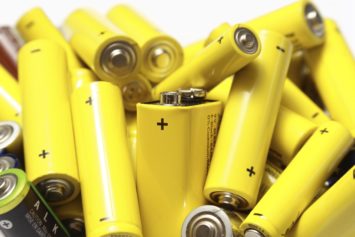Determining whether you are allowed to, and also whether you should, manage certain generated wastes as universal wastes rather than hazardous wastes is a dilemma that can plague a generator of hazardous waste. The questions the issue brings forth range from knowing what hazardous wastes qualify for universal waste management to identifying the perceivable advantages of such management. Let’s take a look.

What Is a Universal Waste?
Certain widely generated hazardous wastes have been designated as “universal wastes” by the U.S. Environmental Protection Agency (EPA):
- Batteries (e.g., nickel cadmium and small, sealed lead-acid);
- Pesticides (recalled or unused stocks of a suspended or canceled pesticide);
- Mercury-containing equipment (e.g., thermostats, temperature gauges); and
- Lamps (i.e., bulbs, such as fluorescent).
Some states have received approval from the EPA to regulate additional types of hazardous waste as universal waste. These additional state universal wastes include aerosol cans, electronics, antifreeze, oil-based finishes, compressed gas cylinders, paint and paint-related wastes, and cathode-ray tubes (CRTs).
What Is the Point of the Universal Waste Rules?
The EPA created the universal waste regulations to encourage the collection and recycling of commonly generated hazardous wastes that were far too often being disposed of in municipal solid waste landfills. EPA’s creation was a hazardous waste generator’s gain, as the universal waste rule provisions are less stringent than the otherwise applicable hazardous waste requirements for:
- Notification;
- Labeling;
- Marking;
- Prohibitions;
- Accumulation time limits;
- Employee training;
- Response to releases;
- Off-site shipments;
- Tracking; and
- Exports.
Advantages to Universal Waste Management
There are definite advantages in opting to manage hazardous waste as a universal waste rather than as a hazardous waste. Here are the main factors to consider:
- Not having to count your waste toward hazardous waste generator status. Since universal waste is not counted in determining a facility’s hazardous waste generator category, it can allow some hazardous waste generators to be a smaller category than they would be if the universal waste was counted as hazardous waste. Lower hazardous waste generator category means fewer regulatory responsibilities. For example, it’s possible that the generation of universal waste, if counted as hazardous waste, could make the generator a hazardous waste small quantity generator (SQG). However, if the waste is managed as universal waste, that waste would not be included in determining generator status, and the SQG could instead end up as a very small quantity generator (VSQG) that is exempt from complying with almost all of the hazardous waste rules that apply to SQGs.
- Being able to store the waste for up to 1 year. SQGs and large quantity generators (LQGs) are limited to hazardous waste accumulation periods of 180 days and 90 days, respectively. However, small quantity handlers of universal waste (SQHUWs) and large quantity handlers of universal waste (LQHUWs) can accumulate their universal waste for up to 1 year.
- Simplified labeling on containers or packages storing the universal waste. The labeling requirements for universal waste are fairly simple; basically, you just label what the item is (albeit with specific language, such as “Universal Waste—Lamp(s)”). In contrast, and especially as a result of the 2017 Hazardous Waste Generator Improvements Rule, SQGs and LQGs must include much more information on the labels of containers that store hazardous waste.
- No need for a hazardous waste manifest and transporter. These are not required for shipments of universal waste. The exception would be when the shipper in a state that has additional state-listed universal wastes (e.g., electronic waste) is shipping that state universal waste to a state that has not included it as a universal waste but regulates the waste as a hazardous waste.
- Recordkeeping is minimal. SQGs and LQGs must keep a myriad of records, such as manifests, hazardous waste determinations, exception reports, employee training records, and biennial reports. SQHUWs do not have to keep any records, and LQHUWs are only required to maintain a record of each shipment of universal waste sent to another facility and those shipments received at the facility.
- Employee training is basic. Although the minimal training for SQHUW employees is almost identical to that applicable to SQGs, the training for LQHUW employees is much less specific and formal than that required for LQGs.
Disadvantages?
It’s hard to qualify any disadvantages to universal waste management, as the whole rationale behind the streamlined set of regulations is to ease the regulatory burden on businesses that generate and manage universal wastes.
So, What to Do?
The decision as to whether to manage your hazardous wastes that qualify as universal wastes under the universal waste regulations at 40 CFR 273 is really an individual choice and may depend, in part, on the quantity of universal wastes that you generate. Is the reality of having two waste management systems worth the additional effort and perhaps space that might be required? It could be a good idea to consult with other generators that have made this choice to gain insight into their perspective.
